|
This recent production of the 1906/7 Ariane and Bluebeard bypassed every reasonable expectation of what it might be, and achieved a stage event every bit as weird as Maurice Maeterlinck (Belgian, 1862-1949) would have hoped. From the long years of deconstructed and postdramatic productions, we are of course familiar with dramas lacking drama, characters, plots, or meaning beyond provocation. This was not that. There was a story, but it unfolded like a stutter and then made a U-turn; it took place somewhere, but where? Symbolist or no, were we allowed to expect that the title character would play a major role, or that the characters would coexist?
No,
all
no.
There
was
a
storyline
that
focused
on
a
group
of
young
women
who
went
to
great
lengths
to
escape
a
locked
chamber
and
who,
without
explanation,
decided:
well,
never
mind.
Maeterlinck
himself
subtitled
the
piece
"The
Useless
Deliverance"—underlining
that
attempts
to
save
the
imprisoned
young
women
wouldn't
give
the
narrative
any
climax
or
closure—and
adopted
his
own
well-never-mind
stance
about
it.
He
wrote:
"One
would
mistake
my
intentions
if
one
hoped
to
find
in
them
any
additional
moral
or
philosophical
designs."
Indeed,
this
slippery
show
was
like
a
puzzle
that
wasn't
complete
until
none
of
the
puzzle
pieces
fit
together.
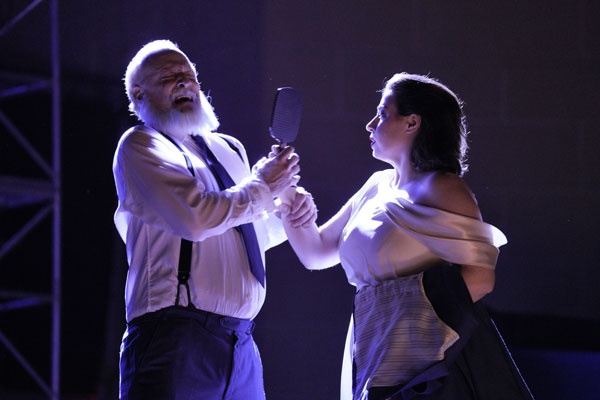
The fearless Ariane (Renée Rapier) forcing the wicked Bluebeard
(Philip Skinner) to look at himself in the mirror.
In contrast, Maeterlinck's collaborator, Paul Dukas (famously the
composer of The Sorcerer's Apprentice) saw the piece as a clear story
about a heroine, Ariane, who arrives to deliver not only the wicked
Bluebeard's captive brides, but also Bluebeard himself. Adding still
another layer, in her fine program notes director Alison Pogorelc
traces her growing interest in applying Carl Jung's theories of
archetypal symbols to the piece, whereby Ariane is "enlightenment
personified," delivering Bluebeard from his own interior obstacles to
"self-actualization."
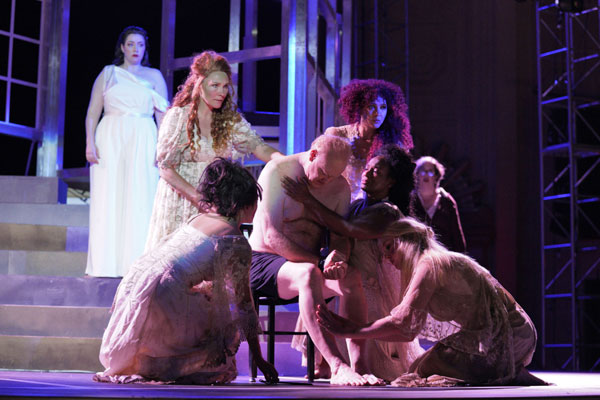
The captive brides refuse Ariane's invitation to leave prison, staying
to nurse Bluebeard, who imprisoned them. Alphabetically: Aléxa Anderson,
Silvie Jensen, Candace Johnson, Taylor See, and Sharon Shao.
While this thread in the opera can certainly be brought to the fore,
Ariane certainly has her work cut out for her: Bluebeard is a violent,
kidnapping sociopath. The young women, too, are hard for Ariane to
rescue—they are easily distracted, by Bluebeard's plentiful stashes of
jewels, from gaining their freedom, and by hand mirrors in which to
admire themselves. Actually, a piece that so embraces a male
"oppressor," and that features a group of women "survivors of abuse"
so intent on not being freed from him—in fact, on staying to tend his
"wounds"—might be seen as a challenging choice for a show in today's
social climate.
But this is what we love West Edge Opera for. Founded in 1979, this
admirable company has given the larger San Francisco Bay Area the
chance to see experimental and intimate operas, often against the
odds: less produced works, Mozartian and earlier; singular pieces from
the early 20th century; and contemporary and new operas.
Exclamations such as exciting! bravura! electrifying! show up regularly
in reviews. If the occasional piece doesn't quite fly, the weakness is
mitigated by the pleasure of seeing a daring experiment in action.

The imposing 1927 auditorium originally used for freemason rites,
now adapted for use as a theatre.
Since early years in one location, the company has set up shop in a
variety of edgy, defunct spaces—an abandoned train station, an empty
warehouse, an old auto assembly plant and the like; audiences have
waited in suspense to learn in what unlikely venue the company will
next make a landing, where they will yet again make a virtue of
theatrical necessity. Their venue for Ariane and Bluebeard was an
Auditorium in the Oakland Scottish Rite Center, built in 1927 as a
temple for Oakland's freemasons, and visually striking at every turn.
Much the largest hall they have played in, and an inspiring setting for
such an unusual company, General Director Mark Streshinsky says
they are crossing their fingers they can make this Center their
permanent home beyond their recently announced 2023 tenure.
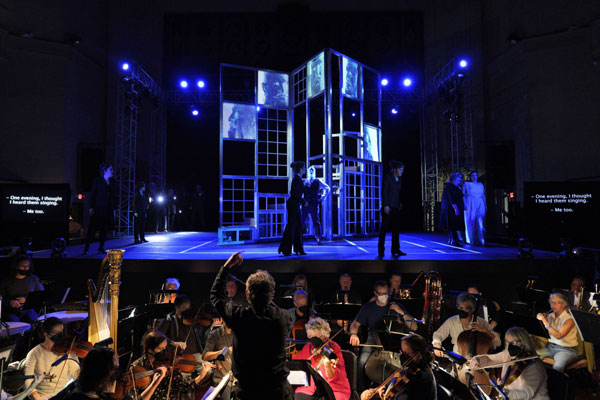
Full view of stage and orchestra. Note the intruding neighbors wielding flashlights
far house left, and the well-placed translations.
I couldn't help but feel well disposed towards the production, all these
elements taken together: in the first place, anything Maeterlinck; then
the creepy tale of Bluebeard as told by Maeterlinck; the gorgeous
music—someone described it as a mix of Wagner and Debussy—along
with the impressive orchestra and its dynamic conductor, Jonathan
Khuner; the thoughtful program notes, my affinity for the company's
mission, on and on. So I was initially perplexed to be perplexed by so
much of the design.
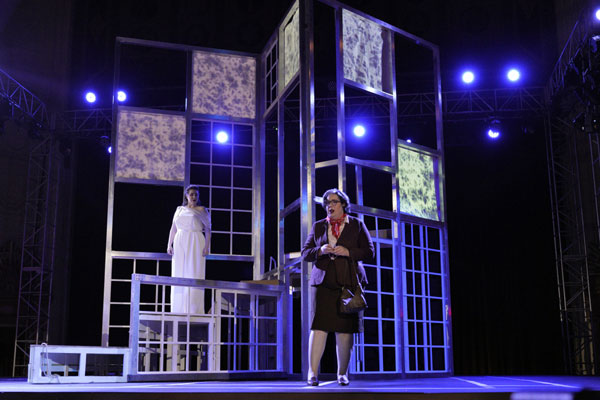
Ariane in an ageless gown, and her Nurse companion (Sara Couden)
in contrasting homely modern attire.
In the first place, most of the piece was played in near darkness. If the
goal was to achieve "shadowy," perhaps it went too far. Also, there was
sometimes a big pool of light with nobody in it, while the action
proceeded in the adjacent dark. I only knew from a pre-show talk that
the girl-women scurrying in the dark were dressed in period wedding
gowns because I couldn't see them until enlightened by the press
photos and video. Ariane was dressed in a period-less, toga-ish gown in
white, and was pretty often visible. Her Nurse companion was in
aggressively homely modern office wear; Bluebeard was in a
contemporary three-piece suit.
The central set piece was like a medium tall, spindly, angular hive,
moveable into different configurations: now it was compressed so the
girls were pinned inside it, now it opened into stairs to give height to
other parts of the action. It looked somewhat dwarfed; it didn't have
quite the oomph to fill the large stage. It boasted cloth panels in its
upper reaches that had frequently changing projections on them with
mostly inscrutable connection to the production. Visually, the structure
of open squares was echoed by a white grid taped on the stage floor,
but I couldn't see that the grid was used to dramatic purpose, although
its perimeter, strangely close to the edge of the stage, clearly served to
mark the border between inside and outside—that is, action outside the
tape was outdoors.
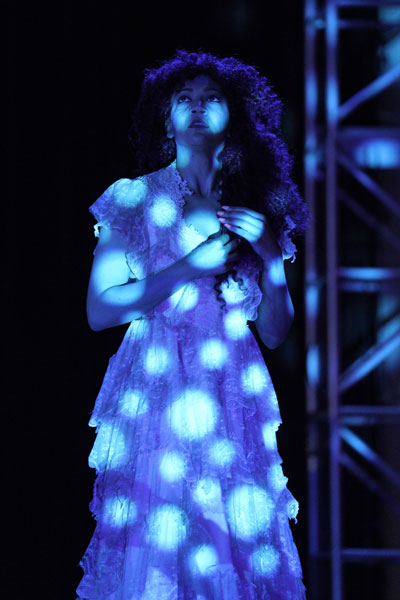
The stage unexpectedly covered in polka dots.
Then, all of a sudden, like a revelation in a dream, I realized: I am
watching a dream. About fear, and the desire for, promise of, and
inability to escape something terrible. And once I started watching
through the lens of dream logic, everything came together—or rather, I
let it fall apart. It also explained why describing the show sounds like
telling a dream: "Well, there were these people, and some other
people, and they were somewhere, but it kept changing, and…" Stop
Making Sense! Of course there was no neat ending to the story—the
show ended when we woke up. And why should all the characters be in
the same era? And in a dream, why would the projected images be
related to anything?
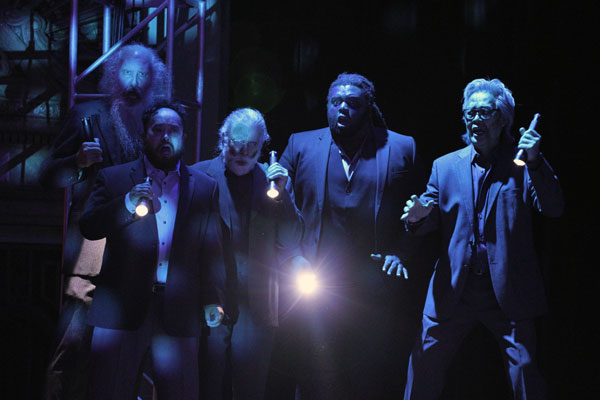
Townspeople (local Peasants alphabetically: Wilford Kelly, Douglas Mandell,
Chung-Wai Soong) lurking to kill Bluebeard for his crimes, without evidence.
The set piece and the squares on the floor swiftly came into focus: a
clear tribute to the conceptual, minimalist grid sculptures of Sol Lewitt
from the 1960s on and, looking backwards, to the 1920s modernist
spatial constructions of Soviet artists Rodchenko and Popova, and even
to Tatlin's famous tower structure of 1920. Why? Why not. It did leave
room in the shadows for the Townspeople, a violent mob that first
greeted Ariane with the fake news that Bluebeard had murdered all the
brides, and on the basis of this Big Lie, later took it into their own
hands to beat Bluebeard within an inch of his life. This too-familiar
posse of dangerous bullies deserved more emphasis in the production.
A closing note of gratitude for the elegantly rendered surtitle
translations by director Alison Pogorelc.

View up into the former freemason auditorium seats; its unusual design
contributed to the show's tenor.
* * *
To get a sense of the show, see the striking trailer (0:57):
https://www.youtube.com/watch?v=Dzi_4Pp6F9c
Additional production credits: Scenic designer, Liliana Duque Piñeiro.
Costume coordinator, Christine Cook. Lighting designer, Pamila Gray.
Projections designer, Jeremy Knight. Wig & Makeup designer, Roxie
Johnson.
An earlier version of this review was published in Critical Stages,
journal of the International Association of Theatre Critics
|